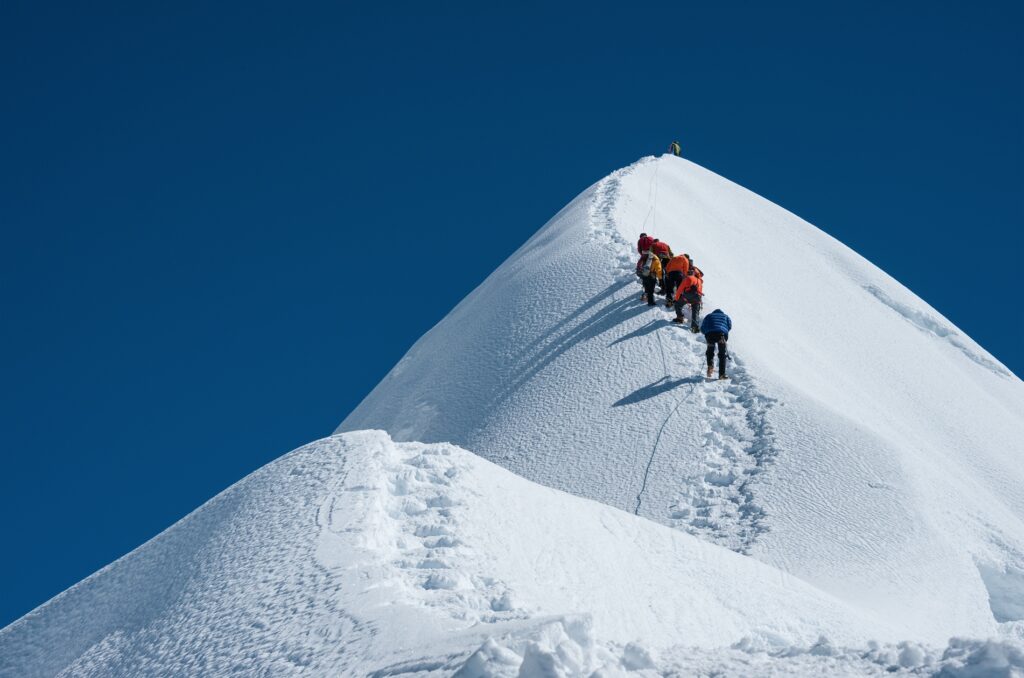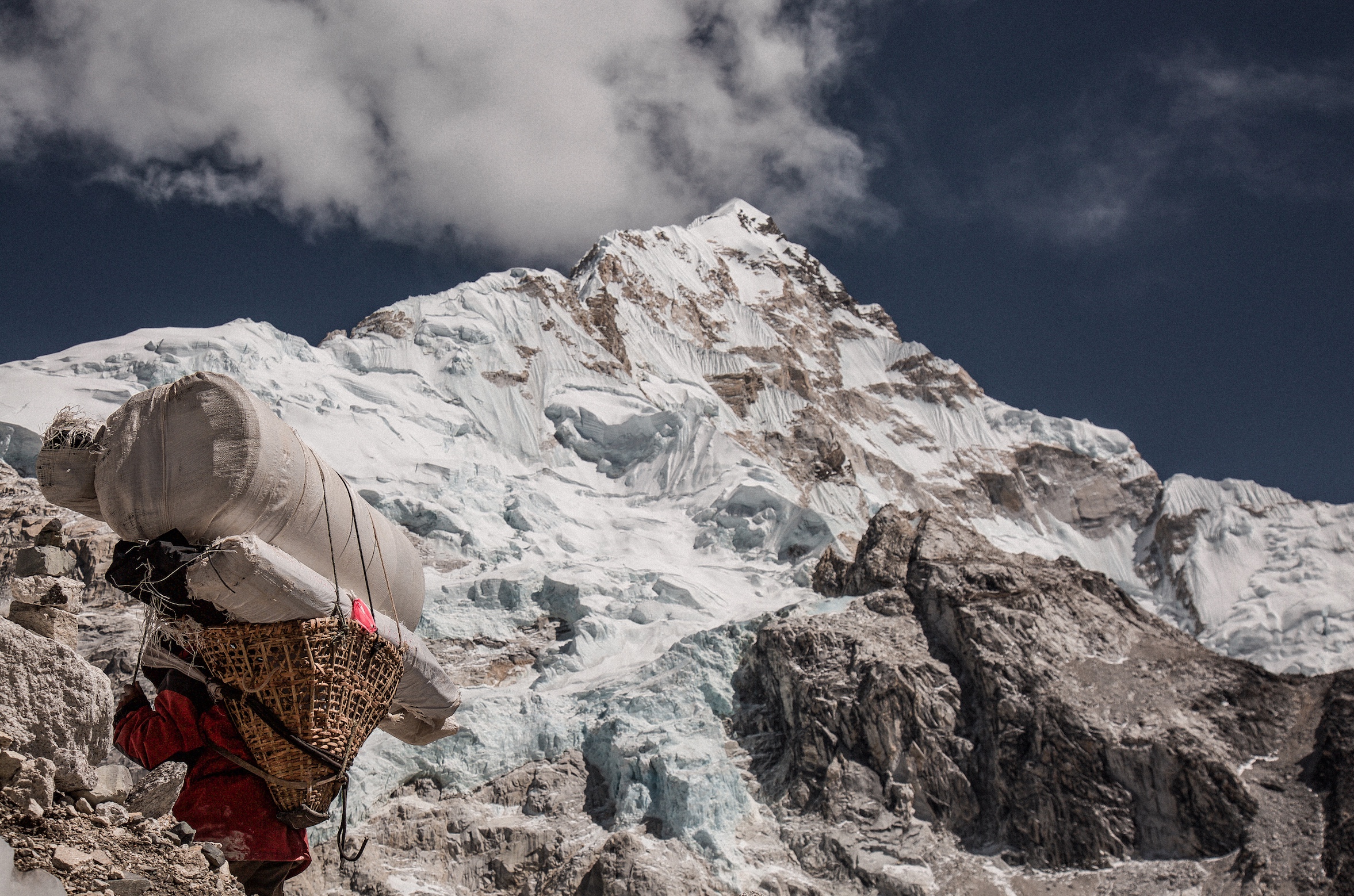Kathmandu, Nepal. March – the beginning of the annual Everest climbing season. The streets of the Nepalese capital are bustling as climbers from all over the world arrive in the “Land of the Thunder Dragon,” all sharing one common goal: To stand at the top of the world.
Every year, more than 800 mountaineers venture East to undertake this treacherous climb. Mount Everest, also referred to as Sagarmatha, the “Goddess Mother of the World,” towers above, standing at a staggering height of 8848m.
The journey to the peak is long and steep – many will fail, some will perish, but without one particular group of people, even the trek to the base camp of the mountain would turn into an unimaginably tough endeavor.
Functioning as the backbone of expeditions in the inhospitable cold of the Himalayas, the Sherpas, sons and daughters of the mountains, have played a crucial part in the many stories of triumph written on the walls, ridges, and faces of the peaks of their homeland.
Yet, their exertions are often overlooked and underappreciated.
The Sherpas: Powerful masters of the ice, unsung heroes of the Himalayas.
A History of Altitude
Natives of the high altitude, the Sherpas, pronounced “Sharwa” in local tongues, have a long history of life on the brutally cold and unforgiving planes of the Tibetan plateau. There, they have spent the past 25,000 to 40,000 years as farmers, traders, nomads, and yak herders.
Under leadership from a great Buddhist lama, the term for a spiritual guide or teacher in Buddhism, this group of able-bodied and enduring people migrated to the mountainous Solukhumbu district in Nepal from the Eastern Tibetan region of Kham roughly 600 years ago. On the quest to create a new sense of “home,” they established the first settlements, with the village of Tengboche still enjoying a great deal of relevance today: It is home to the oldest community of Sherpas and the largest monastery in the Khumbu region.
Religion is deeply ingrained in the culture of these people that originated from the high-altitude desert of Tibet: The majority of Sherpas are Tibetan Buddhists of the Nyingmapa sect. Even at the base camp of Mount Everest, it is a common practice to bring offerings and perform rituals to ask the gods to grant their mercy and benevolence for the risky undertakings that lie ahead. Before having received the lama’s blessings, a Sherpa will not set foot on the sacred mountain.
Naturally, the lives of the Sherpas have changed over time and many of them have strayed away from their traditional nomadic pursuits. Today, the largest part of the 150,000 people of Sherpa heritage still reside in Nepal. Lots of them have now taken up conventional professions, too, yet many continue to stick to their roots and have pledged loyalty to the sport and the mountains of their homeland.
Dancing at the Edge of Life and Death
These “People from the East”, as the term “Shar Pa” can be translated literally, are globally renowned as elite mountaineers and play a crucial role in the success story of mountaineering under the extreme conditions of the Himalayas.
After the failed summit attempt by George Mallory and Andrew Irvine in 1924, Sherpa Tenzing Norgay and Sir Edmund Hillary were the first people to finally stand upon the summit of this peak on the 29th of May 1953 at 11:30 a.m.
Truth be told, the feat of summiting the highest mountain on earth would never have been achieved without these men and women that work tirelessly as porters, cooks, guides, and mediators – committed to doing everything to ensure maximum safety in inherently unsafe situations. A price they often pay with their own life.
“It is just impossible for many of us to continue climbing while there are three of our friends buried in the snow.”
Dorje Sherpa
According to the Himalayan Database, 6,098 different people have managed to repeat this feat, accounting for a total of 10,656 summits.
But the mountain shows no mercy: In the nearly 100-year long history of the pursuit of victory, 309 people have lost their lives on the unforgiving faces and ridges of Mount Everest between 1921 and 2021. 119 of these were hired sherpas. The 2014 avalanche tragedy that claimed the lives of 16 Sherpas working to secure ladders in the Khumbu icefall at Mount Everest base camp sparked protests over poor working conditions, drawing international attention to the oftentimes overlooked efforts of the Sherpas.
Speaking to “The Columbus Dispatch”, Dorje Sherpa, a highly skilled and experienced Everest guide, highlights the dramatic impact of this disaster on the Sherpa community: “It is just impossible for many of us to continue climbing while there are three of our friends buried in the snow.”
New Pattern of Adaptation

This constant dance on the border of life and death has led to unbelievable summit records: The now 52-year-old Kami Rita Sherpa climbed the peak of the mountain a total of 25 times, with many of his kind nearly matching this number.
For an average human body, even one ascent of a mountain this tall is incredibly exhausting. The process of recovery can take several months.
However, the Sherpas, also dubbed “genetically adapted guardian angels of Mount Everest”, have undergone extended genetic adaptation, leading them to function almost effortlessly under hostile conditions and to develop an almost superhuman energy efficiency.
In 1976, an American study found that the unique hemoglobin-binding capacity in Sherpas’ bodies leads to lower hemoglobin concentration at high altitudes. Simply said, hemoglobin is an oxygen-carrier protein in humans’ red blood cells, crucial for the transportation of oxygen to the body’s organs and tissues. Due to this finding and a doubled production of nitric oxide which helps in protecting against damage of the lungs, the risk for developing severe altitude sickness is drastically lower when comparing Sherpas’ organisms to those of average humans.
“[Climbing Everest] feels like running on a treadmill and breathing through a straw.”
Filmmaker David Breashears
In the Death Zone, the part of a mountain that lies above 8000m, oxygen supply is limited to the point where the body actively starts dying cell by cell. Less than six percent of climbers that attempt to summit manage to do so without supplemental oxygen. This comes as no surprise, as oxygen levels from sea level to summit decrease by two-thirds. With every minute that passes, judgment becomes increasingly impaired, and death is a certainty that can hardly be escaped after more than 20 hours.
When asked what climbing in the Death Zone felt like, mountaineer and filmmaker David Breashears made a striking comparison: “[Climbing Everest] feels like running on a treadmill and breathing through a straw.”
In this race against time, Sherpas have a decisive advantage: Professor Denny Levett, Deputy Research Leader for the Caudwell Extreme Everest Expedition 2007, concludes that the efficient mechanism of oxygen utilization in the cells of Sherpas’ bodies has resulted in genetic adaptation to being more resistant to hypoxia, the lack of sufficient amounts of oxygen in high altitude settings.
Reflecting on her second expedition to the Himalayas, Xtreme Everest 2, in an interview with CNN Levett recollects a peculiar memory, strongly demonstrating the utterly impressive abilities of the Sherpas and bowing to their almost superhuman abilities: “He [a Sherpa] came down 2,000 meters [from the top] in just two hours when it took our team the best part of a day. He even stopped for a cup of tea on the way down.”
Sometimes Unsung, Never Invisible
However, the recognition and respect that Dr. Levett and mountaineering legends like Reinhold Messner and Peter Habeler pay to the Sherpas are by no means standard. The dangers that these people put themselves in are in no way proportional to the pay of about $2000 to $5000 dollars per season, and the harsh treatment they are often exposed to by Westerners.
Breaking Chains
“Now, Sherpas and Gurkhas are no longer support staff, they organize expeditions around the world. […]”
Reinhold Messner
Despite the fact that the country was strongly hit by the COVID pandemic, the influx of tourists coming to Nepal is showing no signs of slowing down. If anything, the demand for Sherpas and expedition staff is as high as ever, although this time around, some things may be different.
Speaking to the Nepali Times during his most recent visit to Nepal, Reinhold Messner, the first man to successfully reach the summit of Everest without supplemental oxygen, applauded the Sherpas who have now begun to take matters into their own hands: “Now, Sherpas and Gurkhas are no longer support staff, they organize expeditions around the world. I am very happy that after 100 years the Sherpa have the economic possibility to organize their own expeditions.”

And as the sun sets over Kathmandu, while the snow-capped peaks of the grand mountains tower mysteriously in the backdrop of a landscape covered in a tone of hazy orange, it seems as though the goddess of the mountain herself is paying tribute to these high altitude heroes: often unhailed, but never unnoticed.
Feature Image: Christopher Burns | Unsplash





